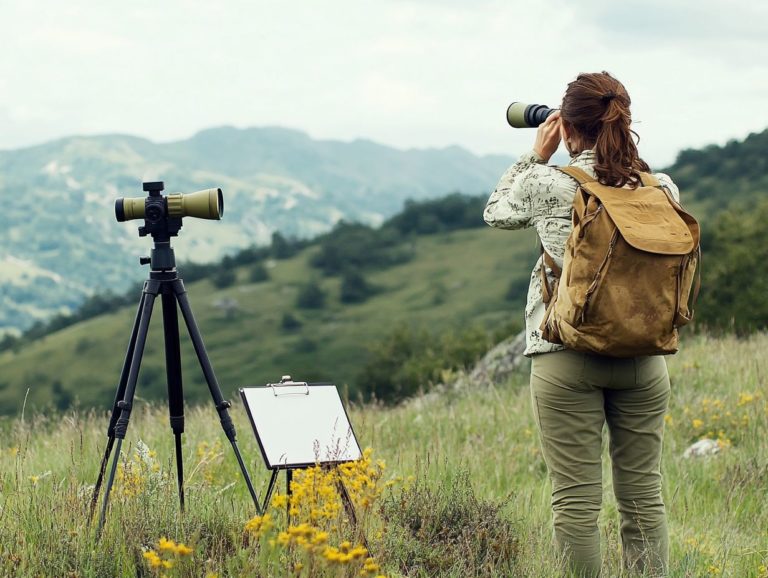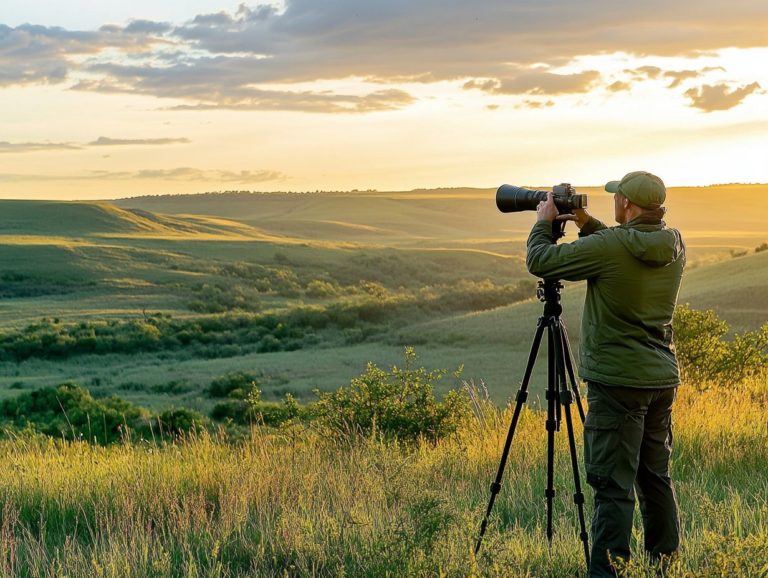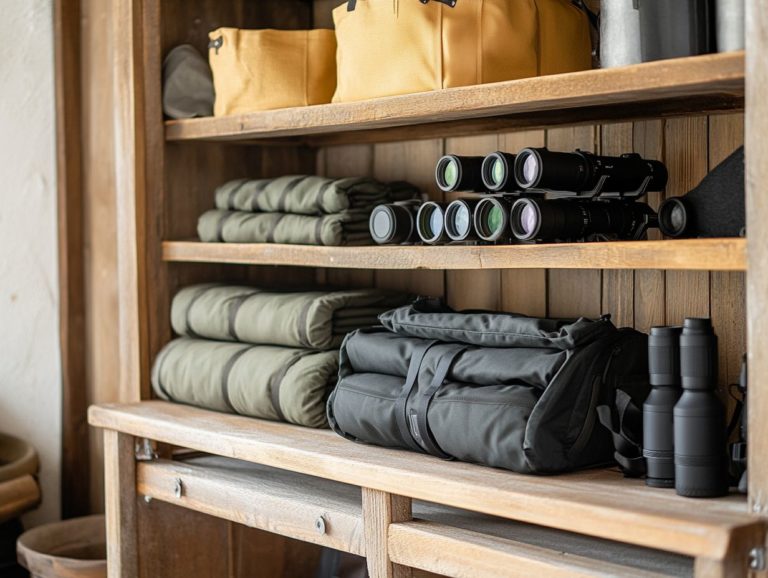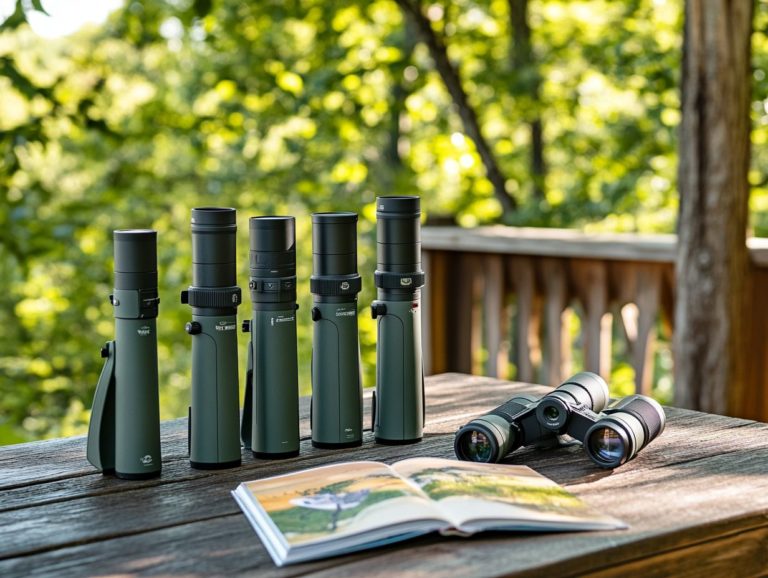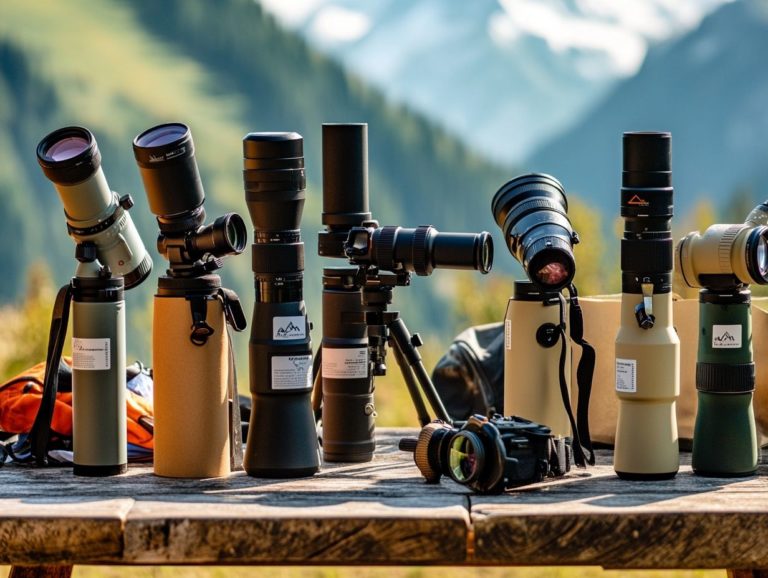Spotting Scope vs. Binoculars: Which is Better?
When it comes to outdoor observation, spotting scopes and binoculars each play a distinct role. They bring unique advantages to the table.
Whether you re immersing yourself in birdwatching, engaging in a hunting expedition, or simply savoring the beauty of nature, understanding the specific uses of these tools can significantly elevate your experience.
This article explores how each device is used, compares essential features like zoom power and image quality, and evaluates cost considerations to guide your decision-making process.
By the end of this article, you’ll feel ready to choose the perfect tool for your next adventure!
Contents
- Key Takeaways:
- Uses and Applications
- Comparison of Features
- Understanding the Cost and Value of Spotting Scopes and Binoculars
- Which is the Better Option?
- Frequently Asked Questions
- What are the main differences between a spotting scope and binoculars?
- Can I use a spotting scope and binoculars for the same purposes?
- Which is better for hunting, a spotting scope or binoculars?
- Do spotting scopes cost more than binoculars? Let s find out!
- Can I use a spotting scope or binoculars for stargazing?
- Which one would be better for birdwatching, a spotting scope or binoculars?
Key Takeaways:
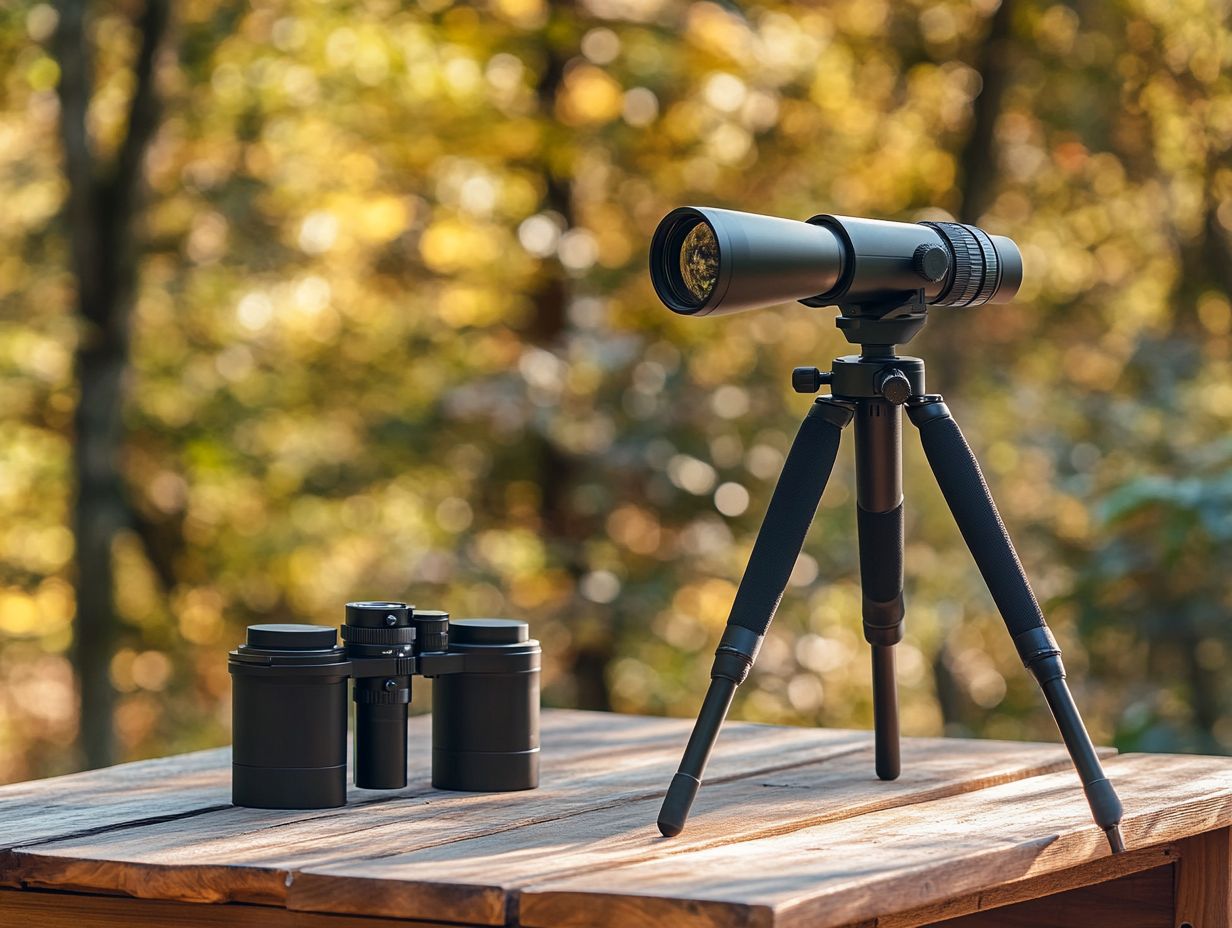
- Spotting scopes excel in long-range viewing and detailed observation.
- Binoculars are ideal for shorter distances and wider views.
- Spotting scopes usually have higher zoom power and larger objective lenses.
- Binoculars are more compact and portable.
- The cost of spotting scopes can be significantly higher due to advanced features.
- Binoculars often provide better value for those on a budget.
What are Spotting Scopes and Binoculars?
Spotting scopes and binoculars are critical optical tools for a range of outdoor activities. Whether you’re immersed in wildlife viewing in Montana or honing your aim at the shooting range, both enhance your visual experience.
The nuances in their design and zoom power can significantly influence how you perceive the world around you.
For example, spotting scopes typically feature longer barrels and impressive zoom capabilities. This makes them perfect for scrutinizing distant subjects in exquisite detail.
In contrast, binoculars are tailored for swift targeting and versatility. They are equipped with two eyepieces to offer a more natural depth of field. Portable binoculars are especially favored for their ease of use in various outdoor settings.
Consider brands like Athlon, which provides models such as the Talos. This model is renowned for its remarkable clarity and affordability, appealing to both amateur birdwatchers and nature enthusiasts alike.
On the flip side, the Vortex Diamondback stands out with its durability and exceptional optics. It caters to both novice and seasoned shooters who need precision for practice or competition at the shooting range.
Whether you’re captivated by the intricate behaviors of birds in their habitat or sharpening your shooting skills at the range, selecting the right optical device is crucial. This choice maximizes your enjoyment and effectiveness in these outdoor endeavors.
Uses and Applications
Spotting scopes and binoculars serve a diverse range of purposes. They are essential companions for outdoor enthusiasts engaged in activities like hunting, wildlife observation, and spectator sports, including target shooting.
Their versatility also shines in fields such as astronomy and target shooting, where clarity and precision are crucial.
By understanding the specific applications of these optical devices, you can choose the perfect equipment to elevate your experiences. Whether you’re scanning a distant bean field or marveling at the stars during an adventure in Montana, quality optics will enhance your experience.
Specific Purposes for Each
Spotting scopes and binoculars serve specific needs for outdoor enthusiasts. Whether you re target shooting, hunting, or stargazing, understanding their designs helps you make informed choices.
A high-powered spotting scope is great for target shooting. In contrast, portable binoculars are ideal for tracking wildlife and enjoying games from the stands.
Magnification power is critical. If you love stargazing, consider a scope like the Nitro 15-45×65 for distant celestial observations.
If hunting is your passion, mid-level magnification binoculars, such as those with 10×42, offer a broader field of view for spotting game.
Portability is equally important. A lightweight binocular fits easily in your backpack for hikes.
A robust spotting scope, like a 30x model, might be heavier but is invaluable for long-distance observations during a hunt.
Understanding these features helps tailor your choices for maximum enjoyment and effectiveness on every outdoor adventure.
Comparison of Features
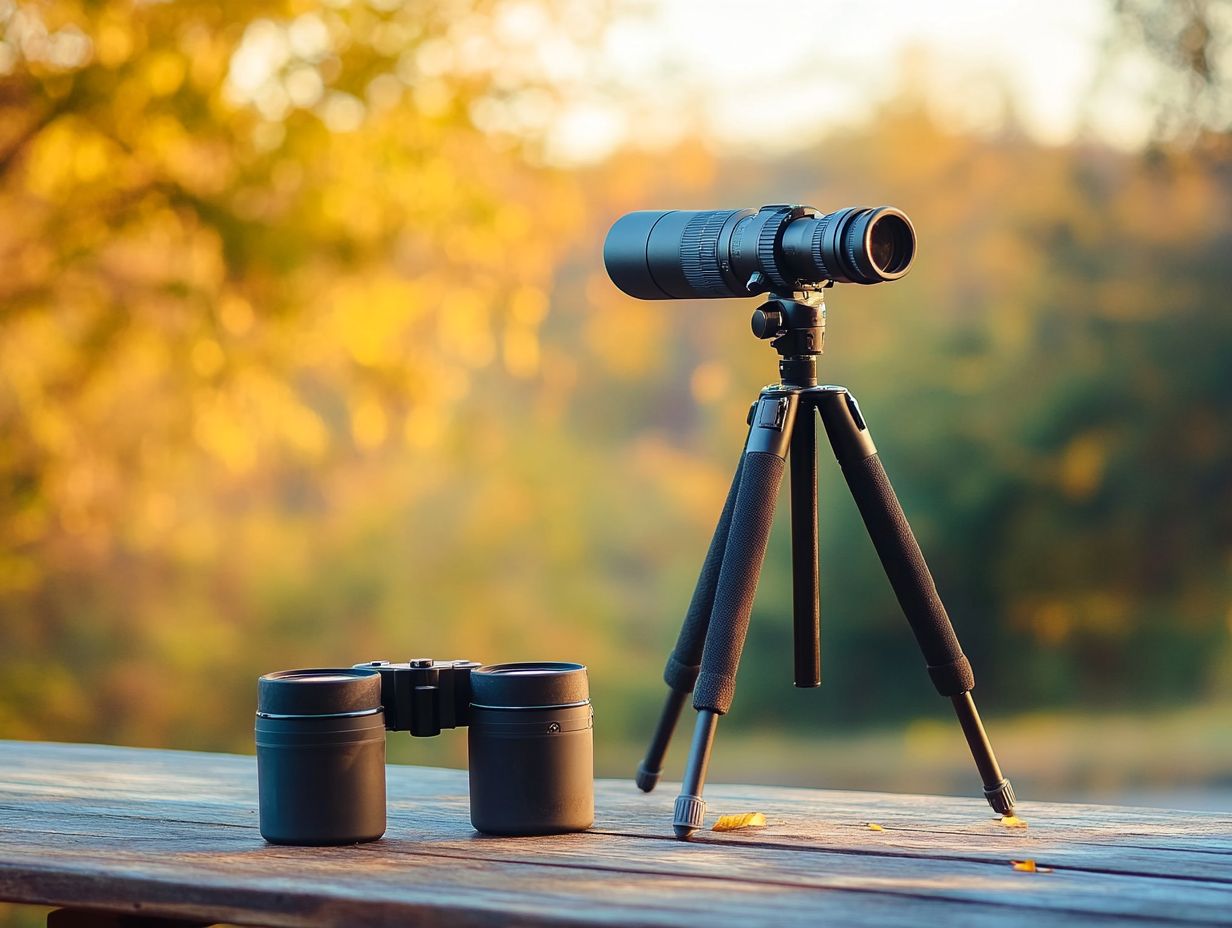
Comparing spotting scopes and binoculars reveals key differences in magnification, weight, and portability. These factors can significantly influence your choice as an outdoor enthusiast.
Spotting scopes are designed for stationary use, while binoculars are lightweight and allow for quick scanning. Image quality, especially lens coatings, is crucial for choosing the right device for wildlife viewing, target shooting, or astronomy.
Magnification Power and Field of View
Magnification power shapes the effectiveness of spotting scopes and binoculars. Options range from fixed 30x scopes to adaptable models like the Nitro 15-45×65.
Spotting scopes typically offer higher magnification than binoculars, which usually provide levels around 10×42 or 12×50. This difference allows for clearer views of distant objects.
A high-powered spotting scope enhances target shooting by showcasing precise details at long distances. Binoculars with 10x magnification and a wide field of view are invaluable for wildlife enthusiasts.
For instance, the Vortex Diamondback 20-60×80 scope has a powerful zoom for spotting game in remote areas. Meanwhile, the Nikon Monarch 10×42 binoculars provide a broader view for observing animal behavior during hikes.
Both types of equipment show how attention to magnification power and field of view can elevate your outdoor experiences.
Weight and Portability
When you’re choosing between spotting scopes and binoculars, weight and portability are essential factors, especially for outdoor activities that require mobility. Spotting scopes often come with a bulkier, heavier design, making them less ideal for on-the-go adventures, particularly when considering the need for clear viewing.
In contrast, lightweight binoculars are a dream for easy transport. They allow you to track wildlife or enjoy spectator sports without succumbing to eye fatigue, which is crucial during prolonged viewing sessions. Recognizing how weight influences usability can guide you in selecting the perfect optical device for your specific outdoor pursuits.
For hikers and birdwatchers embarking on lengthy treks, the compact design of binoculars allows for effortless handling. You can scan your surroundings swiftly without the burden of extra weight. Spotting scopes offer superior magnification capabilities, such as the 65-70mm scope, but their heft might deter spontaneous excursions; lugging a heavy device for miles can quickly become cumbersome.
As an outdoor enthusiast, aiming for comfort and performance is key. By opting for lightweight options like binoculars, particularly the Forge Binoculars, you enhance your experience and ensure you’re always ready to capture those fleeting moments in nature without feeling weighed down or fatigued.
Image Quality and Clarity
Image quality and clarity are essential when evaluating spotting scopes and binoculars. These factors significantly impact your visual experience and comfort, especially during long viewing sessions, particularly in terms of the light received by the lenses.
Consider the importance of special coatings on the lenses; they enhance light transmission and reduce glare, directly affecting how clear and vibrant the images appear. The quality of the glass used in these optical devices, particularly with high-powered models, can dramatically alter sharpness and brightness. Keep this in mind as you choose your equipment.
Don t overlook the optical design either. Features like field curvature which affects focus across the image and chromatic aberration correction, which reduces color fringing, can significantly enhance your viewing experience. By keeping these elements in mind, you can ensure your investment yields not only great image clarity but also an enjoyable experience that minimizes strain, especially for those engaged in outdoor sports.
Understanding the Cost and Value of Spotting Scopes and Binoculars
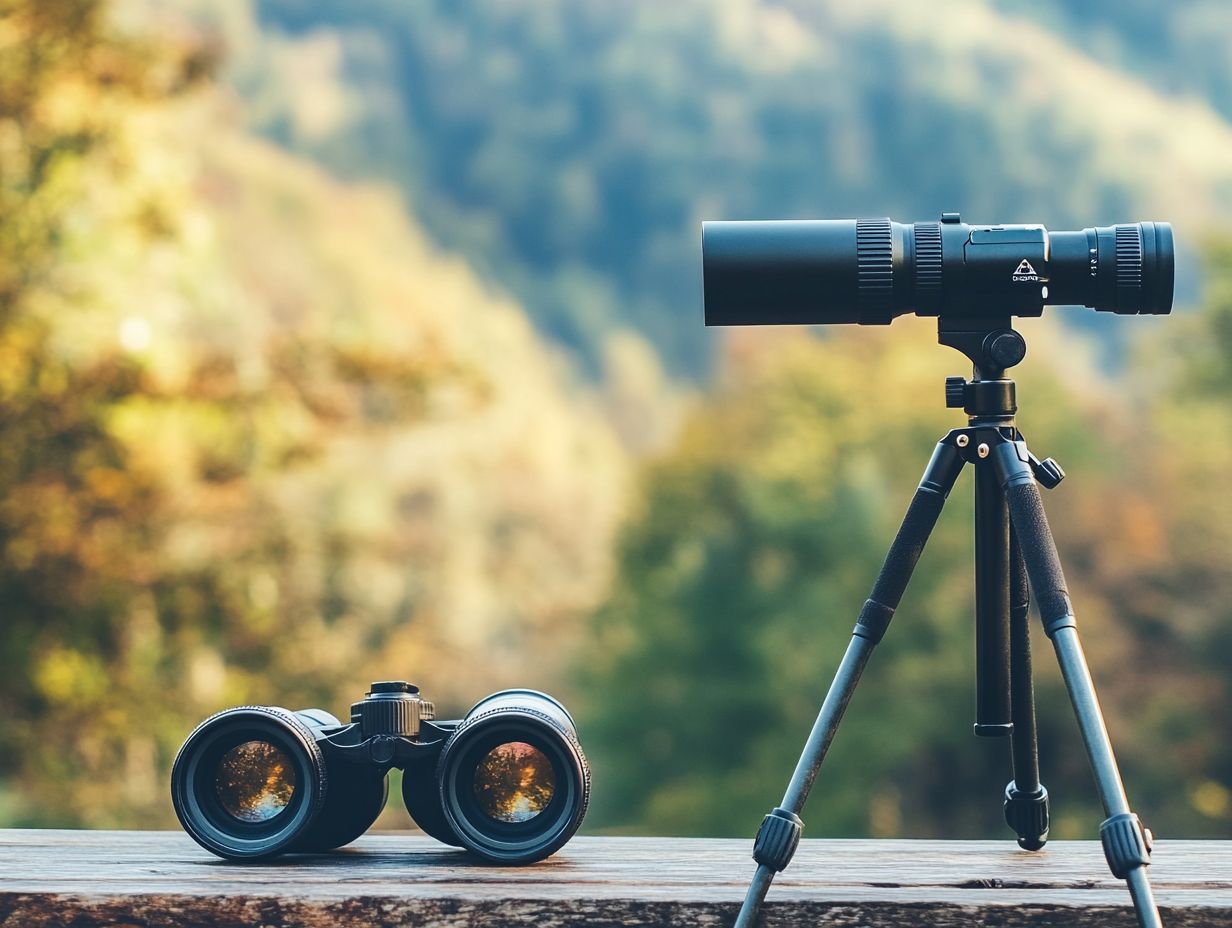
The distinctions in cost and value between spotting scopes and binoculars often reflect the diverse features and capabilities of these optical devices. It s crucial to grasp your specific needs and budgetary limits.
While premium models provide great clarity and impressive magnification, more budget-friendly options can still offer satisfactory performance for outdoor enthusiasts. Striking the right balance between cost and performance will enable you to make the best gear choices for your outdoor adventures.
Factors Affecting Price
Several factors influence the price of spotting scopes and binoculars, including quality optics, brand reputation, and the feature set. High-quality devices with advanced features typically command higher prices, while budget-friendly options may sacrifice some performance aspects. By understanding these variables, you can navigate the consumer niche effectively and choose equipment that aligns with your specific needs and financial considerations.
The type of outdoor activities you engage in be it birdwatching, hiking, or astronomy can significantly affect how you perceive the value of these devices. A dedicated birdwatcher might prioritize superior light transmission and image clarity, making a premium brand worth the investment for them. Conversely, occasional campers might find a mid-range model perfectly adequate.
It s also wise to consider the warranty and customer service associated with the brand, as these factors can greatly influence your long-term satisfaction. Weigh these elements against your budget and intended usage to make an informed decision that enhances your outdoor experiences. Explore your options and find the perfect device for your adventures today!
Which is the Better Option?
Choosing between spotting scopes and binoculars comes down to your unique needs and preferences. If you re an outdoor enthusiast involved in various activities, understanding these options will greatly enhance your experiences.
Spotting scopes excel in clarity and high magnification for stationary viewing. They are perfect for target shooting or observing wildlife in stunning detail. In contrast, binoculars are versatile and portable, making them ideal for dynamic pursuits like hunting or enjoying spectator sports.
Recognizing how these factors align with your personal requirements is crucial for making an informed decision.
Considerations for Choosing Between Spotting Scopes and Binoculars
When deciding between spotting scopes and binoculars, several key considerations come into play, particularly for your outdoor activities and specific goals. Evaluate key factors like how well you can see, magnification range, and portability. Your choice could transform your outdoor experiences!
If your goal is to observe distant landscapes or wildlife in detail, a spotting scope might be the better option due to its higher magnification capabilities. However, if you re engaging in activities that require mobility, such as hiking or birdwatching, binoculars are often lighter and more portable.
User comfort is also essential; binoculars typically offer a more relaxed viewing experience for extended periods, while spotting scopes may require a more stable setup. Ultimately, it s about weighing these factors against your personal preferences to select the right device that enhances your outdoor adventures.
Frequently Asked Questions
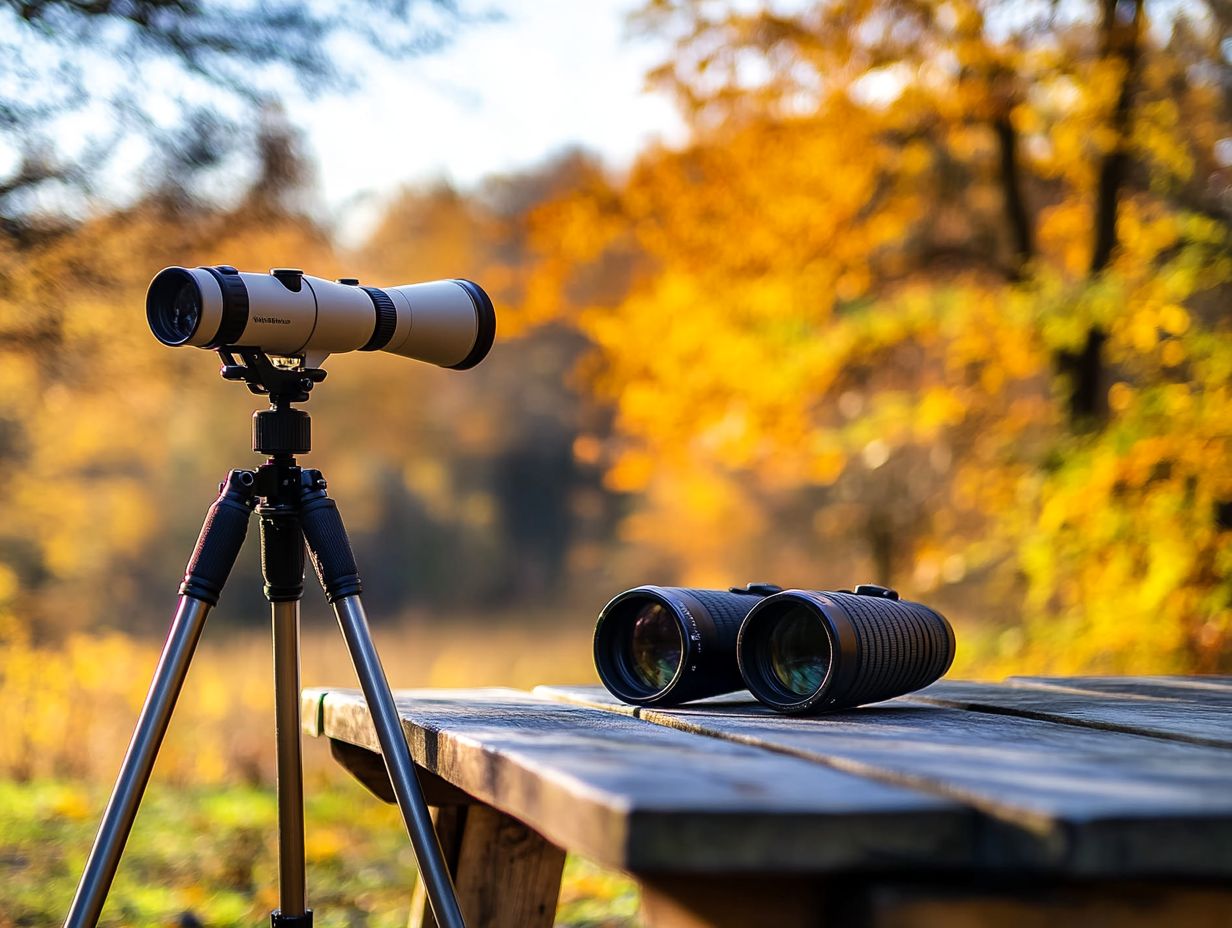
What are the main differences between a spotting scope and binoculars?
The main difference lies in magnification. Spotting scopes generally have higher magnification and are designed for long-distance viewing, while binoculars offer lower magnification for shorter distances.
Can I use a spotting scope and binoculars for the same purposes?
Yes, both spotting scopes and binoculars can be used for similar purposes like birdwatching, hunting, and wildlife observation. However, they excel in different situations and have unique strengths and weaknesses.
Which is better for hunting, a spotting scope or binoculars?
This depends on your hunting environment. In open areas with long distances, a spotting scope is preferable. In dense areas, binoculars may be more suitable.
Do spotting scopes cost more than binoculars? Let s find out!
In general, yes, spotting scopes tend to be pricier due to their higher magnification and specialized design for long-distance viewing. However, some high-end binoculars can also exceed the cost of certain spotting scopes.
Can I use a spotting scope or binoculars for stargazing?
Both spotting scopes and binoculars can be used for stargazing, but a telescope is a better option as it has higher magnification and is specifically designed for viewing celestial objects.
Which one would be better for birdwatching, a spotting scope or binoculars?
This depends on your personal preference and the type of birdwatching you are doing. Spotting scopes provide a clear and detailed view of birds from a long distance, while binoculars are more portable and better for shorter distances or for observing multiple birds at once.
Ready to choose your perfect optical companion? Dive into the adventure today!

